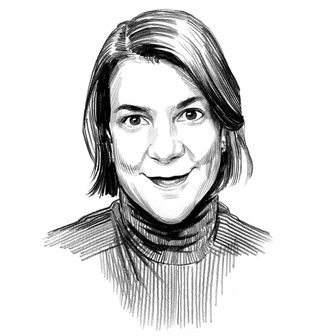In case you needed more reasons to be baffled by the modeling industry’s definition of “straight-size” and “plus-size,” Paulina Porizkova provided it during yesterday during the Glamour Women of the Year conference at 92Y. “Excuse me, I have to do this,” she said, interrupting her fellow panelist Crystal Renn mid-sentence. “Crystal, can the two of us stand up next to each other for a moment, so that the audience can see us?” Renn obliged, and the two women stood shoulder-to-shoulder. “I’m pretty much the same size now that I was in the eighties, when I was actually modeling, and I was known for doing bathing suits,” explained Porizkova, who if anything looked larger than Renn once they stood side by side. “Here’s Crystal, a plus-size model,” she said, gesturing toward Renn. “This is a plus-size model in 2010. This [she pointed to herself] is an average-size model in 1980. Times have changed.”
Unsurprisingly, Renn had plenty to add to this:
What I would like to see is a bunch of different-sized models in fashion. Right now, we have extremes. We have size 2s and size zeros, and then over here we have size 14s and 16s. What I would like to see happen is that you watch the runway and you see all different sizes — you see 2s, you see 4s, you see 6s, we see 12s and 14s. Then there’s no controversy about body size. Then it’s all about the clothes.
She did note that things have been looking up lately, in terms of diversity in model sizes:
These days, I’m seeing more 4s and 6s, which is considered bigger compared to what it was eight years ago. Is there still pressure? Of course. Are things changing? Yes, they are. I think we’re still not where we need to be … ultimately, when I see the runway, I don’t want to stick out. I want to see everybody up there.
She also presented an easy way to make runway work more accessible to a more diverse spectrum of models: Designers simply need to make their sample sizes bigger.
I think that the solution would be to make the sample size an 8 or a 10. It’s currently a 2, or a 4 if you’re very lucky. If you made it an 8 or a 10, then bigger girls — even 12s and 14s — could somehow get into the clothes, and also the 8s and 6s and 4s and 2s could have the clothes pinned on. I know from working in the plus-size industry, they have pinned clothes to me when it’s been a sample size 24. I’ve seen it work for a plus size, and I have no idea why we don’t have size 8s and 10s as sample sizes for straight-size models. Because right now, we’re all talking all the time about how we want to see fuller-figured women in fashion, but that’s really impossible unless we have the clothes.
In the meantime, Renn reads blog comments to see where people need further convincing.
I absolutely read what people say about me, because I want to know where we’re weak in this whole conversation. So I read blog comments. And one person will say, ‘Wow, she’s so fat. Look at her. She’s so obese.’ And then right underneath, someone else will say, ‘Look how emaciated she is. She’s so anorexic.’ Fat is relative. One person’s thin is someone else’s so-called fat.





